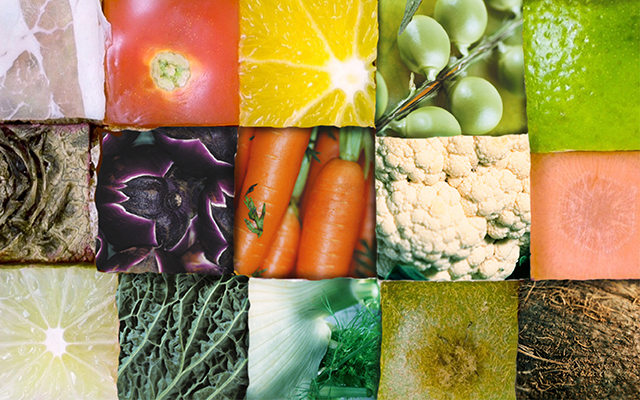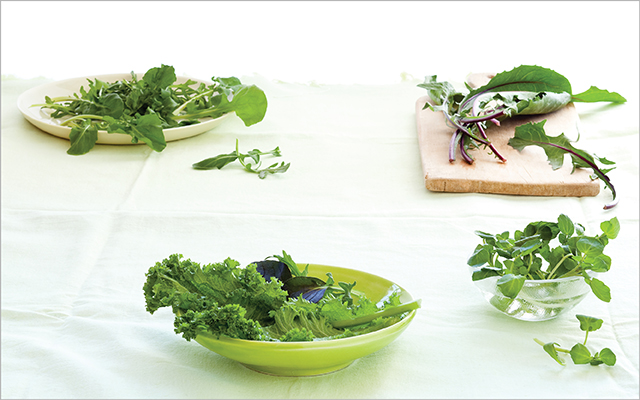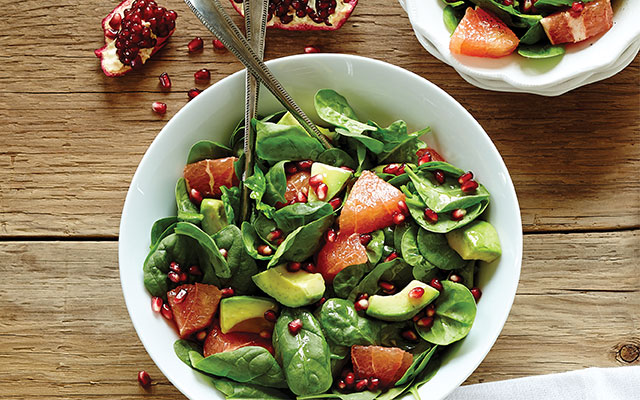Explore this article:
- The Role of Ethylene in Plant Ripening
- 5 Ways to Protect Your Produce
- How to Store Fruit and Vegetables
Cruising through the produce section at the grocery store, you may think of the whole foods on display as little more than inert merchandise, no different from all the boxed foods in the center aisles. But the amazing truth is that the kale, cucumbers, apples, and peaches you buy and eat are actually living, breathing entities.
Like other living things, they have quirks and quibbles. They are prone to bumps and bruises. They get injured when they’re mishandled and even pant in the heat. Each has a complex internal chemistry — and a short lifespan.
“Fruits and vegetables are not manufactured, static items,” says Russ Parsons, author of How to Pick a Peach: The Search for Flavor from Farm to Table. “They develop and adapt and age just like the rest of us.”
Indeed, from the beginning of their existence, veggies and fruits change in response to their environments. “Plants react to wind and temperature, soil, and stars,” says biodynamic beekeeper and farmer Gunther Hauk, author of Toward Saving the Honeybee. To illustrate, Hauk explains that seeds sown three days before a full moon have a higher germination rate than seeds sown three days before a new moon.
Left to their own devices, plants will do everything they can to satisfy their basic need for light and water: following the sun with their branches, tilting their leaves to catch rainfall, pushing their roots down and out into the soil in search of nutrients.
Given this special “intelligence,” it shouldn’t be a surprise to discover that how a piece of produce lives its life — how it is raised, nurtured, handled, and marketed — dramatically affects its flavor and nutrient profile. Understanding the inner workings of your favorite veggies and fruits can help you enjoy them while they’re in their prime.
Strength and Vulnerability
Just as we have stem cells that develop into the different cell types needed to support our growth and healing, plants have meristematic cells for the same purpose. Found in meristem tissue, these cells can morph into flowers, fruits, roots, or whatever the plant needs.
“When you remove a tip or shoot, say by pruning, the plant responds by releasing hormones,” says Preston Andrews, PhD, emeritus professor of horticulture at Washington State University. Those plant hormones signal meristem tissue in buds near the pruned site and tell the cells to transform into new shoots or flowers.
“When you remove a tip or shoot, say by pruning, the plant responds by releasing hormones,” says Preston Andrews, PhD.
Plants also have skeletons, made of cellulose instead of bone. Cellulose can take many forms, from the bell-shaped flesh of a red pepper to a foot-long crunchy stalk of celery. It has a hollow, matrix-like structure that is strong and flexible; this helps plants resist hailstorms and wind gusts.
More importantly, the honeycombed cellulose walls protect delicate fluid-filled vacuoles inside the plants’ cells. Like microscopic piñatas, these vacuoles contain a brew of compounds that give veggies and fruits their flavor, aroma, and color, as well as their antioxidants and phytonutrients.
One of the most vital of these compounds is chlorophyll. Responsible for absorbing sunlight for photosynthesis (and giving plants their colorful hues), the chemical constituents of chlorophyll are similar to the heme structure of hemoglobin in human blood. Once we ingest them, these chemicals act as powerful detoxifiers of our blood and tissues.
Resilient and powerful though these plants are, they can also be vexingly delicate. Plant skin is vulnerable to infection. The smallest nick or puncture wound on the surface can become a festering sore. Yeasts and molds lurking on the surface speed to the cut to feast on whatever juices, sugars, and organic acids leak out.
Cuts on the surface of fruit can also lead to enzymatic browning. Most produce — especially apples, pears, bananas, and artichokes — contain substances that, when exposed to oxygen, change the flesh color to brown. The browning itself doesn’t affect the taste or nutrients, but it does affect a fruit’s commercial appeal.
Surface nicks aren’t a fruit’s only worry. Too much pressure can bruise delicate produce, squashing cell walls and sending fluids flooding into damaged tissue. Unlike bruised human tissue, however, bruised produce flesh doesn’t heal. A blemish on a piece of fruit can accelerate ripening and dehydration, which leads to premature death.
Even vibrations caused by trucking produce to market can be harmful. Vine-ripened tomatoes, for instance, must be carefully packaged to ensure the gel around the seeds isn’t shaken to the point that it falls out of the fruit the moment it’s cut, explains James Gorny, PhD, vice president of food safety and technology for the Produce Marketing Association. He notes that upward of 25 percent of all vegetables and fruits picked in the United States are lost to such damage.
Rough handling doesn’t just make for less-attractive produce; it can also lower its nutrient content. A bruised tomato loses roughly 15 percent of its vitamin C.
The Role of Ethylene in Plant Ripening
Similar to people, edible plants owe their aging — or ripening — to a surge of hormones. Instead of testosterone and estrogen, plants rely on a powerful hormone called ethylene.
Ethylene triggers cell walls, rigid with cellulose, to soften. It also dissolves pectin, the glue that binds plant cells. Exposed to enough ethylene, a plant’s cell walls become more pliable and permeable. In fruits, this eventually promotes the mingling of compounds that create their juice and soften their skin.
“Ripeness is not a fixed point but a process,” explains Parsons. “It begins with pollinated flowers forming fruit and it ends with rot.”
“Ripeness is not a fixed point but a process. It begins with pollinated flowers forming fruit and it ends with rot.”
As fruit ripens, its flavor becomes fuller and more complex; the flesh sweetens as simple sugars and starches (both of which contain glucose) morph into more-complex fructose and sucrose.
Vegetables ripen more slowly than fruit, meaning they live longer and are less fragile. And unlike fruit, a vegetable releases its flavor (and often its smell) only when its cells are crushed — when chewed, diced, or cooked. (See “Optimize Your Onions” below.)
Veggies are usually ripe when you buy them, but fruits like apples, bananas, melons, and mangoes are often picked early due to their fragility, which puts the onus on either the seller or the consumer to see them through the last step. The savvier you are about this ripening process, the better you’ll be able to take advantage of the fruit’s peak moments of taste and nutrition — and avoid a soggy, fly-infested fruit bowl.
Fruits that ripen after picking, such as pears, bananas, and tomatoes, are called climacteric; nonclimacteric fruits, such as strawberries, mandarins, and grapes, refuse to ripen after being removed from their parent plants. (For insights on what you can do to ripen and extend the postharvest life of veggies and fruits, see “Protect Your Produce,” below.)
Ripening is a formidable hurdle for growers who want to get their produce to consumers at the height of flavor. Some commercial producers blast their fruit with ethylene gas at the warehouse, forcing it to ripen on demand. That will cause fruit to soften and change color, but it can’t add sugar or any of the other chemicals that add up to a complex flavor, explains Parsons.
“Picked at just the right moment and ripened this way, a tomato can be adequate, but it will never be great.”
Living, Breathing Produce
When so much of the food we buy is packaged in cardboard and plastic, it can be easy to forget that much of it came from living plants.
Empty a package of instant oatmeal into a bowl and try to visualize the graceful stalks of grain that produced it. It’s a stretch. But take one look at a bright-red apple or chubby purplish-black eggplant, and the magnificent transformation of energy from sun to plants to people is undeniable.
Whether you appreciate veggies and fruits for the complex science they represent, the surprising consciousness they embody, or the nutritious and delicious eating experience they deliver, having insight into their secret lives may just help you view them with newfound respect.
Optimize Your Onions
The onion is a classic example of a vegetable that doesn’t achieve its full flavor potential until its cells are destroyed, first by chopping and then by heat, says plant biologist and retired University of Arizona professor Stephen Goff, PhD. Onion cells are composed of tiny pockets that compartmentalize the vegetable’s various chemicals. Cutting an onion destroys the cellular matrix and allows these chemicals to mingle. Only when the chemicals interact with one another is the classic onion flavor expressed.
The process takes a little time, so don’t rush your freshly chopped onions into the sauté pan. “Foodies recommend letting onions sit for at least 10 minutes after cutting them and before cooking them,” says Goff, who also advises placing them in an airtight container to trap the gases and force them to interact. “During that time, they generate volatile organic compounds that convert to water-soluble flavors and, ultimately, infuse your cooking with a deeper, more complex flavor.” (Try this macerated onion recipe.)
5 Ways to Protect Your Produce
With fragile flesh and delicate hormones, it’s no wonder that produce is raced to market. “Most fruits are never going to be any better than on the first day you pick them,” says James Gorny, PhD, vice president of food safety and technology for the Produce Marketing Association. “There is nothing we can do to enhance quality; it’s all about preventing decay.” As a result, skilled handlers have developed several tricks to help veggies and fruits age gracefully — techniques you can use at home as well.
1) Keep them cool.
Vegetables and fruits need to breathe — technically, to respire — and their rate of respiration is linked to temperature. When they are hot or physically taxed, for example, plants “pant,” or increase the rate of respiration. Respiration is a cellular-level chemical reaction that draws on plants’ energy stores, causing them to break down their starches, sugars, and organic acids — all of which create flavor — into simpler molecules. The less veggies and fruits breathe, the more flavor they retain. Interestingly, not all produce breathes at the same rate: Asparagus, broccoli, mushrooms, and peas breathe 10 times faster than apples, cabbage, lemons, and tomatoes.
2) But not too cool.
Take care how much you restrict respiration, though: Chill a fruit too much and you’ll destroy enzymes necessary for ripening. “Mealy, dry peaches get that way because something went wrong during ripening, storage, or transport,” says Gorny. “Most likely, the enzymes involved in the softening process — which results in sweeter, juicier fruit — were destroyed by exposure to too-cold temperatures.”
3) Mind the gas.
To avoid accidentally speeding ripening (and rotting), separate ethylene-producing fruits, like apples and avocados, from non-ethylene-producing vegetables and fruits, like leafy greens and bananas. But you can use ethylene gas to your advantage: It can gently speed up the ripening of certain fruits, such as pears. “Pears are a very weird fruit in that they won’t ripen until they’ve been picked,” says Russ Parsons, author of How to Pick a Peach. Bring green pears to ripe perfection on the countertop. Or, if you’re in a hurry, place a few pears in a paper bag and fold the top down; the bag will trap the fruits’ ethylene gas and accelerate the ripening process.
4) Watch them closely.
As a piece of fruit ripens, its enzymes convert simple sugars and starch into more-complex fructose and sucrose, a process you can easily observe with bananas. At cool temperatures, bananas remain green and starchy. But when they are left on the countertop, the sugar conversion occurs, and chlorophyll breaks down to highlight bananas’ natural bright-yellow jackets. “It’s a complex chemical ballet,” says Gorny. Eat a banana at just the right moment and enjoy a lovely array of floral aromas and a firm, creamy texture. Wait too long and you end up with bland mush.
5) Be strategic with starch.
Cooking high-starch vegetables, like potatoes, carrots, and beets, softens their structure and amplifies their natural sweetness. A note on potatoes: Chilled potatoes will convert some of their starch to sugar. “That’s fine if you want them sweet,” Gorny says, “but try to make French fries out of them, and the excess sugar turns the flesh black or brown.” For that reason, potatoes are best stored at room temperature.
How to Store Fruit and Vegetables
By the time veggies and fruits make it to your kitchen, they’re entering the twilight of their lives, so it’s important to store them properly. Scientists at the University of California, Davis, Postharvest Technology Center offer the following storage recommendations.
Storage: Room Temperature
Store at room temperature — on the counter, in the pantry, or in a drawer — and use while fresh.
Fruits
|
Vegetables
|
Storage: Counter to Fridge
These fruits will ripen gradually on the counter but don’t do well in the fridge for long. Refrigerate only when ripe or if cut, and not for more than a day or two.
Fruits
- Avocados
- Kiwis
- Nectarines
- Peaches
- Pears
- Plums
- Plumcots
Storage: Refrigerator
These foods spoil quickly unless kept cool. Take care not to over-cool your fridge: Icy temperatures hasten the demise of veggies and fruits.
Fruits
|
Vegetables
|
*Store in a well-ventilated area in the pantry. Protect potatoes from light to avoid greening.
+Can be kept in the refrigerator for up to three days.
Reproduced with permission from Storing Fresh Fruits and Vegetables for Better Taste by Adel Kader, PhD; Jim Thompson; Kathi Sylva; and Linda Harris. University of California, Davis, Postharvest Technology Center.




This Post Has 0 Comments